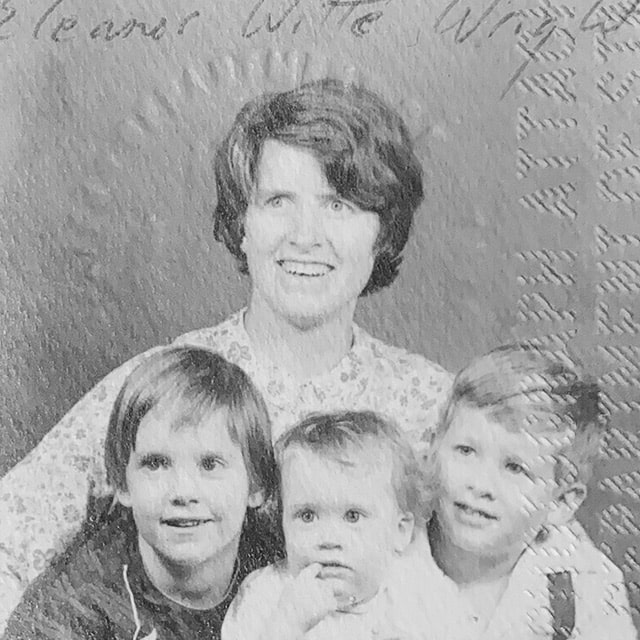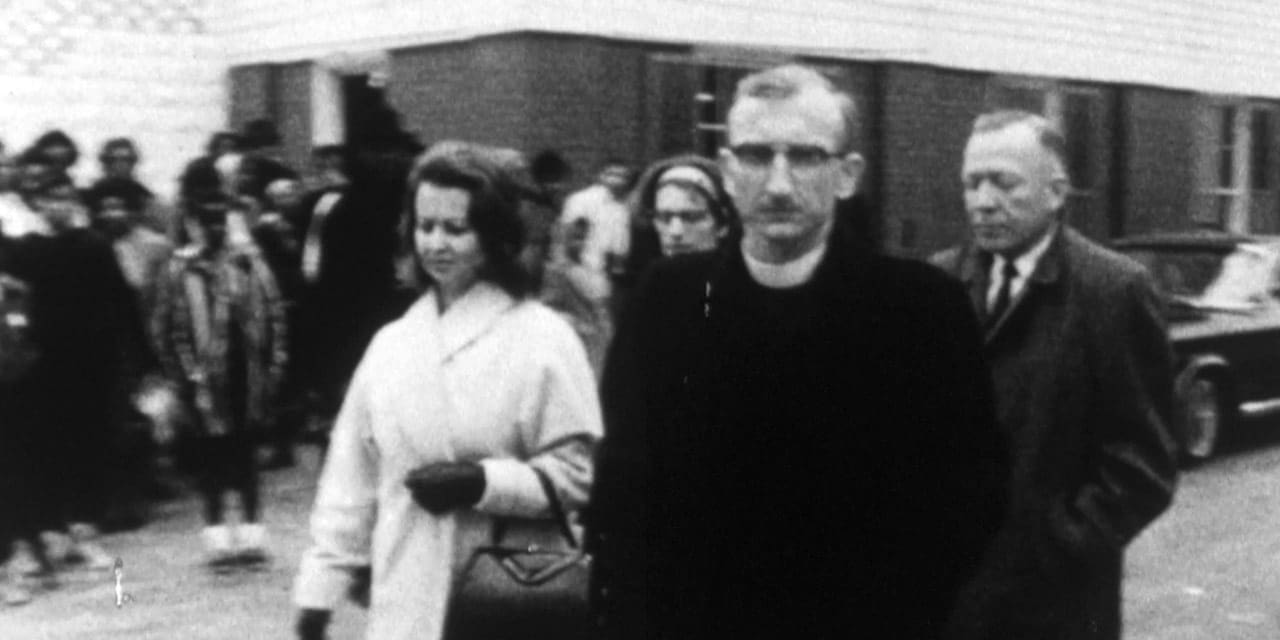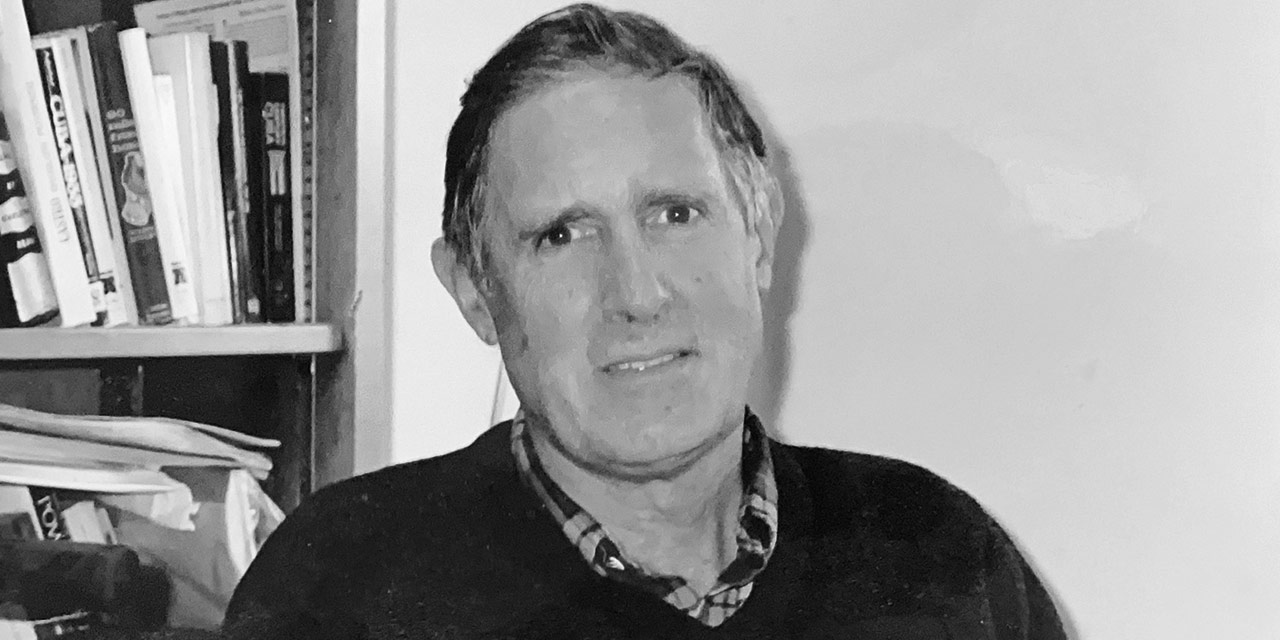Bending the Arc | The Vote is a film about the hard-fought battle to expand voting rights to all people in Alabama in the 1960s. The film will premiere on Tuesday, October 20, at 6:30 PM CST via YouTube. Register for the free virtual event on Facebook or .
The Day Before:
A Civil Rights March
Lost in History
Gail Short
In 1965, just one day before one of the most famous and iconic events in civil rights history took place in Selma, Alabama, a little-known act of defiance occurred when a group of white Alabamians held a demonstration to protest voting discrimination against Blacks.
History professor Winthrop Wright wrote about this act of bravery in his book manuscript, “On the Road to Selma: White Activists in Birmingham Alabama, 1955-65.”
In the manuscript, Wright, who died in 1996, told the story of 72 white Alabamians who called themselves the Concerned White Citizens of Alabama (CWCA). On March 6, 1965, they marched through the streets of Selma to the Dallas County Courthouse to state publicly their opposition to laws and local policies that prohibited most Black citizens in the state from exercising the right to vote as their white counterparts were able to do.

After learning about the CWCA and the group’s Selma march for voting rights for Blacks, historian Winthrop Wright set about to interview the participants in that event.
On following day, on March 7, State Troopers in Selma tear gassed, whipped, and billy-clubbed a large crowd of peaceful Black voting rights demonstrators as they attempted to cross over the Edmund Pettus Bridge. And all of it was televised.
The photo and film images of the State Troopers’ attack shocked the nation, and the incident was soon dubbed “Bloody Sunday.”
Having eclipsed the CWCA march, Bloody Sunday saturated the nation’s consciousness and provided the spark needed to spur change. Months later, on August 6, President Lyndon Johnson signed the Voting Rights Act of 1965 into law, putting an end to the laws that prevented Blacks from voting.
An Untold Story of Courage
Historians and filmmakers have retold the story of Bloody Sunday in countless books, articles, and documentaries. But the CWCA march has remained an untold story until recently.
Wright learned about the CWCA and their march for civil rights from friends at the Unitarian Universalist Church in Birmingham who had participated in the event.
Admiring their commitment to justice, Wright set out to tell the story of the CWCA members. He recorded interviews wherein they described their backgrounds and the day when they risked harassment and even physical harm to march for equal voting rights, says his widow, Polly Wright.
Bloody Sunday saturated the nation’s consciousness and provided the spark needed to spur change.
“Rob’s desire to write this manuscript as a historian was to give recognition to the courage and bravery of white individuals who worked to end segregation between 1955 and 1965, against many odds,” she says. “He felt they had been overlooked in most historical works.”
To this day, however, Wright’s manuscript remains unpublished.
An “Innate Sense of Fairness and Service”
Wright’s interest in the civil rights movement in Alabama started in 1963. That year, the Wrights moved to the state after he, a native of Philadelphia, accepted a teaching job at the now defunct Birmingham-Southern College.
She recalls the drive to Alabama in their VW bus with their 11-month-old and two-year-old in tow.
“We were young when we came down. We weren’t thinking we’d come to save the world,” she says. “It was a very different world, and I think both of us were certainly committed to civil rights and human rights from way back when.”
“Rob had an innate sense of fairness and service. He was deeply affected by our experience in Birmingham and focused his academic and personal life on human rights and civil activism.”
Wright says her husband was deeply affected by the tragedy that occurred in Birmingham during their first week in the city. That is when white supremacists planted a bomb at the Sixteenth Street Baptist Church, a prominent Black congregation in Birmingham that was the center of the demonstrations in the spring of 1963. The bomb exploded on a Sunday morning, Sept. 15, 1963, killing four Black girls.

Wright’s globetrotting family included his wife, Eleanor (Polly), and their children from left to right, Lisa, Chris and Jed Wright.
Wright says the tragedy at Sixteenth Street Baptist Church inspired her husband to support the civil rights movement in any way he could.
Birmingham-Southern College’s administration, however, forbade activism.
“Right after the bombing, the dean at the college said that there was to be no association with any group on the left or the right. Rob and another professor, Tom Leonard, went in and said they were going to resign if that was going to be so,” she says.
“The dean showed them that he had to say it, but that he didn’t really mean it,” she says.
This led Wright to co-found the Birmingham chapter of the American Civil Liberties Union (ACLU) and to host on-campus student dialogues on integration.
Outraged by Disenfranchisement of Blacks
The CWCA, founded in 1965, was an offshoot of the Greater Birmingham Council on Human Relations (GBCHR). The GBCHR members were white professionals who supported the civil rights movement by promoting dialogue between the races.
Wright says in his manuscript that before 1965, liberal whites such as the GBCHR members rarely participated in civil rights protest demonstrations, choosing instead to watch from afar or to stay away from them altogether.
The idea for the CWCA and its march in Selma, says Wright, came about following a GBCHR meeting on Feb. 23, 1965, at the First Congregational Christian Church, a Black congregation in Birmingham, led by the Rev. Harold Long.
The GBCHR guest speaker was Black civil rights activist Hosea Williams, who, at the time, was a staffer with the Southern Christian Leadership Conference (SCLC).
During his speech, Williams described the violence that Black civil rights activists often experienced and discussed plans to march from Selma to Montgomery to demand their right to vote as guaranteed by the U.S. Constitution.
Before 1965, liberal whites such as the GBCHR members rarely participated in civil rights protest demonstrations.
At the time, Black citizens in Alabama often faced violent retribution for attempting to vote; they were forced to pass a literacy test and a test on the Constitution to qualify to vote.
In fact, the 1901 Alabama Constitution disenfranchised Blacks, not only by requiring passage of literacy tests, but also by imposing poll taxes and requiring registrants to answer questions that had nothing to do with voting.
To further ensure Black disenfranchisement, county boards of registrars around the state declared any mistake a Black citizen made on a literacy test as reason enough to disqualify them from becoming a registered voter.
Standing up for Voting Rights for All
William’s speech deeply moved several of the GBCHR members, and they asked how they could help. So, he challenged them to show up in Selma and demonstrate on behalf of Black voting rights.
Some GBCHR members resisted the idea of joining the protests. But others agreed, and those members formed a new entity, the CWCA, rather than seek permission from the Alabama Council on Human Relations, the state organization, Wright said.
The CWCA consisted of white schoolteachers, professors, homemakers, ministers, and college students from Birmingham, Tuscaloosa, Montgomery, Auburn, and Huntsville, and, according to its statement of purpose, the CWCA wanted to go beyond just promoting interracial dialogue. They wanted to go public in standing up for justice for all. They wanted to promote the spirit and the letter of the U.S. Constitution, the Bill of Rights, and the Alabama Constitution by nonviolent, nonpartisan action.

Before moving to Venezuela on a Fulbright scholarship in 1966, Wright co-founded the Birmingham chapter of the American Civil Liberties Union at Birmingham-Southern College and hosted on-campus discussions about racial integration.
“It shall be our concern that life, liberty, and the pursuit of happiness be shared equally by all persons in Alabama,” the statement says.
Wright describes how soon afterward, trainers with the SCLC, led by Al Lingo, held a clinic to teach CWCA members how to organize a march and how to respond to taunts and beatings by white mobs through passive resistance when protesting.
With the training complete, on the morning of March 6, 1965, the 72 CWCA members caravanned down to Selma and gathered at Knox Presbyterian Church, with plans to march from the church to the Dallas County Courthouse and demand an end to the disenfranchisement of Blacks.
On the morning of March 6, 1965, the 72 CWCA members caravanned down to Selma, with plans to march to the courthouse to demand an end to the disenfranchisement of Blacks.
A Mob with Baseball Bats and Lead Pipes
Rev. Joseph Ellwanger, the pastor at St. Paul Lutheran Church in Birmingham at the time, led the march. His wife, Joyce, was five months pregnant with their first child and Ellwanger recalls how he made sure she marched in the middle of the line.
“I didn’t want her up front because I thought that if we were going to get bashed, it would be the people in front who would get bashed and she would be protected,” he says.
But, as it turned out, the middle of the line got the worst of the threats and the taunts from the gang with the weapons, Ellwanger says. He recalls the fear that he and others in the group felt as they marched to the County Courthouse while a crowd of white people began gathering on the street and jeering and taunting the CWCA members.
The group turned the corner off Broad Street and onto Alabama Avenue and marched over to Lauderdale Street, where the county courthouse was located. Meanwhile, the mob continued growing larger, Ellwanger says.
“When we came to the courthouse, we saw up to 500 white men in the street there with clubs and baseball bats and lead pipes and all kinds of battering weapons that they could use,” he says.
“We the white citizens of Alabama have come to Selma today to tell the nation that there are white people in Alabama who will speak out against the events that have recently occurred…”
Ellwanger says a handful of sheriff’s deputies held the white mob at bay, keeping them from physically attacking the CWCA marchers.
“But we didn’t know whether the sheriff’s deputies would really hold back the gang from attacking. Although, I must say, I was so focused on getting to the courthouse and making our stand known that I had to discount the presence of all of these people in the street,” Ellwanger says. “I had a low level of fear, but not enough that I would even consider turning around or not pursuing what we came to do.”
“We were there to make our stand public”
When the marchers reached the County Courthouse, Ellwanger says a deputy stood in front of the group and read a telegram from Ellwanger’s bishop, the president of the Southern District of the Lutheran Church Missouri Synod.
“It basically said that Rev. Ellwanger does not represent the Lutheran Church Missouri Synod in his actions in Selma today,” Ellwanger says.
“And I remember saying to the sheriff’s deputy, when asked how I would respond, that he had a right to his own opinions, but that we were there to make our stand public and clear that there were white citizens in Alabama that supported the voting rights campaign in Selma, and could we proceed to the steps of the courthouse so that we could make our statement,” he says.
At that point, Ellwanger says the deputy could have either arrested the CWCA protesters, motioned the mob to attack them, or prevented them from going any farther.
Some CWCA members faced backlash from their communities when they returned home.
“But instead, he stepped aside with the other sheriff’s deputies who were with him,” Ellwanger says, “and we walked between them to the steps that faced Alabama Avenue, and I read the statement that we had prepared.”
“We the white citizens of Alabama have come to Selma today to tell the nation that there are white people in Alabama who will speak out against the events that have recently occurred in this and neighboring counties and towns.”
The statement also called for an end to the intimidation and harassment against Blacks attempting to register to vote.
“We consider it a shocking injustice that there are still counties in Alabama where there are no Negroes registered to vote and where Negroes have reason to fear the hostility and harassment of public officials when they try to register.”
“Dixie” vs. “We Shall Overcome”
The CWCA also demanded that officials inform Black residents that they were welcome to register to vote and that the federal government and State Legislature go on the record as being against the use of “college tests” as a requirement for voter registration.
After reading the statement Ellwanger says he and the rest of the group sang “America the Beautiful.”
O beautiful for spacious skies
For amber waves of grain
For purple mountain majesties
Above the fruited plain!
America! America! God shed His grace on thee
And crown thy good with brotherhood
From sea to shining sea
“While we were singing that hymn, the yokels in the street started singing ‘Dixie,’ he says.
I wish I was in the land of cotton, old times there are not forgotten,
Look away, look away, look away, Dixie Land.
And the chorus:
Then I wish I was in Dixie, hooray! hooray!
In Dixie Land I’ll take my stand to live and die in Dixie,
Away, away, away down South in Dixie,
Away, away, away down South in Dixie.

Rev. Joseph Ellwanger led the Concerned White Citizens of Alabama’s voting rights march in Selma the day before Bloody Sunday.
In contrast, Ellwanger says a crowd of about 300 Black residents, standing on the opposite side of Alabama Avenue, began singing “We Shall Overcome.”
We shall overcome
We shall overcome
We shall overcome, someday.
Oh, deep in my heart
I do believe
We shall overcome, someday.
“Those three songs really symbolized the situation at the time in the South because there was certainly the majority of whites in the South who stood with the good ol’ Dixie song, which really was saying that we’re going to stay with segregation, and this is our way of life, and we’re not going to change,” he says.
“But there were a handful of a few whites who would not go along with that and would be praying for brotherhood and sisterhood,” Ellwanger says.
Meanwhile, the song “We Shall Overcome” symbolized the strong commitment of the Black community in Alabama and around the country to bring about change and overcome, he says.
The Aftermath
Afterward, the CWCA members turned, walked past the white mob and the Black supporters, and headed back to the Presbyterian church where they piled into their vehicles and caravanned out of Selma.
Some of the white men followed the caravan to intimidate the CWCA, but they eventually fell away, and the demonstrators made it back home safely, Ellwanger says.
The next day, March 7, Bloody Sunday occurred.
Two days after Bloody Sunday, marchers attempted to cross the Edmund Pettus Bridge again, but it ended when the Rev. Martin Luther King Jr., decided to wait for permission from the Justice Department to proceed with the Selma to Montgomery march, making it possible for federal protection for the marchers, Ellwanger says. The aborted march that day became known as “Turnaround Tuesday.”
On March 17, federal Judge Frank Johnson Jr., ruled in favor of the march. So, on March 21, hundreds of demonstrators gathered in Selma for the start of the march to Montgomery in support of voting rights for all; three hundred people were chosen to make the entire 50-mile march, with federal protection.
The CWCA march received little press attention, swallowed up by the larger, more dramatic events of Bloody Sunday and the final Selma to Montgomery march.
Ellwanger points out that, unlike the CWCA march, many of those who participated in that Selma to Montgomery march were from all parts of the United States and not from Alabama.
“And so that’s why the Concerned White Citizens of Alabama and their march was really unique,” he says.
Some CWCA members faced backlash from their communities when they returned home, Ellwanger says. Parishioners at a church in Clanton, for example, fired their pastor after learning that he participated in the CWCA march.
Another member had a cross burned in her yard.
But the CWCA march received little press attention, swallowed up by the larger, more dramatic events of Bloody Sunday and the final Selma to Montgomery march, along with the murders of two activists, Rev. James Reeb. and Viola Liuzzo, in Selma during and after the marches.
Winthrop Wright, however, wanted to keep the story of the CWCA march alive.

Wright spent years searching for a publisher for his manuscript on the CWCA, to no avail.